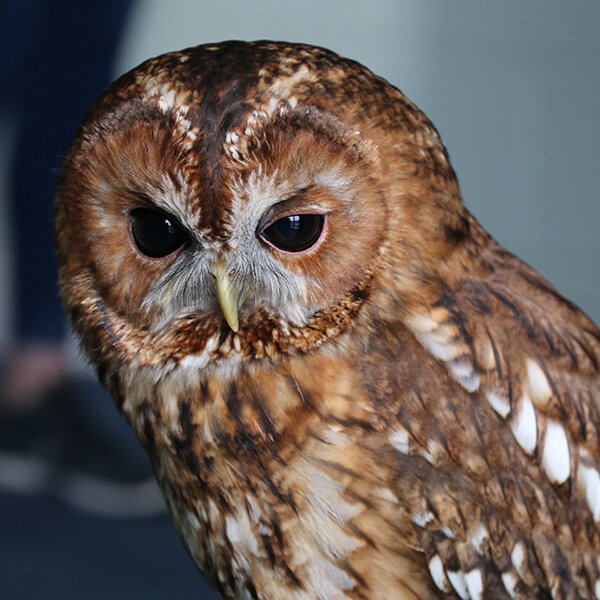Tawny owl
Strix aluco
The tawny owl is our largest common owl, with a rounded body and head, and a hooked beak. They are chestnut brown, and have large dark forward-facing eyes , and dark feathers creating a ring around its face. The mottled patterning help camouflage the bird when perched high up in woodland. They stand up to 39cm tall and have a wingspan of up to 1m. Males and females are very similar in appearance but the females are the larger of the two sexes.
Tawny owls primarily live in deciduous broad-leaved woodlands, but can also be found in farmland, hedgerows and forestry. They will also inhabit more urban areas including parkland if there are plenty of mature trees. They nest in tree cavities, squirrel drays or old nests made by other bird species, or will also use purpose built nestboxes.
What they eat
Tawny owls feed mostly on small mammals (such as mice and voles), small birds, amphibians and large insects and earthworms.
Where and when to see them
They can be seen all year round.
Tawny owls are nocturnal….you will have stay up late to spot them.
Don’t forget to listen out too – tawny owls hoot.
Look carefully at night - they can look quite pale in car headlights.
View a tawny owl 10km distribution map of Wales.
Legal status
Barn owls are protected by law under the Wildlife & Countryside Act 1981, and have been given a UK conservation status of Amber.
Field Signs
As with many species, it is not always easy to see owls. However, they often leave signs that reveal they have been present.
Pellets
A pellet containing the undigested parts of prey items (e.g. bones, teeth, fur) is regurgitated (i.e. coughed up through the beak) and discarded; they are often found in or under a roost/perch site.
The pellets of tawny owls measure around 20-50mm long and are usually greyer and more obviously furry than those of the barn owl. They are usually a bumpy, irregular shape and are often less solid than other owls’ pellets and can break into pieces when they hit the ground.
Droppings
Tawny owl droppings are usually white. Look underneath potential perch or roost sites.
Feathers
Tawny owl feathers are gingery-brown with dark bands. However, they can look like the feathers of other birds so check along the edges for serrations (like a comb) which allow them to fly silently (like other owls).
Calls
The hooting call of a male tawny owl is one of most familiar of any bird calls. It is a drawn out ‘hooo’ followed by a softer ‘hu’, and then a repetitive ‘hoohoohoohoooo’. The female’s call is a ‘keewick’. A pair will often duet with the male and female taking turns to call and making the classic call of ‘twit twoo’. Hooting most often occurs at night, although some calling can be heard in daylight.
Did you know?
Tawny owls do not occur in Ireland, and the collective noun for a group of owls is a parliament!


